
The fastest street-legal Viper track car ever offers a tremendous value for performance
May 12, 2015 , Auburn Hills, Mich. – Viper enthusiasts with the need for ultimate handling, performance and road course domination, as well as the ability to drive their Viper home from the track, can now place their orders for the fastest street-legal Viper track car ever. The Dodge brand has announced pricing and opened order banks for the recently introduced 2016 Dodge Viper ACR.
Unveiled last week at the revamped Conner Avenue Assembly Plant in Detroit, the American Club Racer model of the iconic, hand-built American supercar will have a starting U.S. Manufacturer’s Suggested Retail Price (MSRP) of $117,895 (excluding destination and gas guzzler tax).
“Bringing our street-legal Dodge Viper ACR back is going to arm our track enthusiasts with the ultimate weapon to dominate road courses across the country,” said Tim Kuniskis, President and CEO — Dodge and SRT Brands, FCA — North America. “This is without a doubt the best Viper ACR ever. The latest in aerodynamic, braking and tire technology will ensure its legendary performance reputation around the world.”
Originally introduced in 1999 and last available for the 2010 model year, the Viper ACR has a long-standing legacy as the ultimate street-legal track car for club racing. The new 2016 model honors that performance legacy with significant aerodynamic and suspension upgrades, new Carbon Ceramic brakes with six-piston calipers and high-performance tires specifically designed for ACR. Standard equipment highlights include:
- Delivers ultimate in stopping performance with unprecedented brake fade resistance through ACR-exclusive Carbon Ceramic Matrix 15-inch two-piece rotors and six-piston front calipers from Brembo®
- Unique track suspension features 10-setting, double-adjustable, Bilstein coil-over racing shocks and unique race alignment delivering up to 3 inches of suspension height adjustment for fine-tuning corner weight
- The latest race tire compound technology with massive Kumho® Ecsta V720 high-performance tires (295/25/19 front, 355/30/19 rear), designed and developed specifically for the 2016 Dodge Viper ACR, delivers laps times that are 1.5 seconds faster than off-road only race tires
- Combination of suspension, aero treatment and ACR-specific tires delivers sustainable 1.5 g cornering during high-speed turns
- Lightweight carpet, minimal three speaker audio and manual seats designed to manage weight and maintain optimal 50/50 weight distribution
- Powered by iconic, hand-built 8.4-liter V-10 engine rated at 645 horsepower and 600 lb.-ft. of torque – the most torque of any naturally aspirated sports-car engine in the world
- Unique Alcantara hand-crafted interior to assist driver stability under high G-loading features iconic ‘ACR’ dash badge and accent stitching
- Offers ‘1 of 1’ customization option for the ultimate personalized Viper track car
- Optional ACR Extreme Aero Package (late availability) delivers nearly 1 ton of peak downforce at top speed through massive adjustable dual-element carbon fiber rear wing, rear carbon fiber diffuser, unique SRT hood with removable louvers, detachable extension for the front splitter and additional dive planes
Production of the 2016 Dodge Viper ACR will begin in third quarter 2015 at the Conner Avenue Assembly Plant. Vehicles will start arriving in dealerships in the third quarter of 2015.
FASTEST STREET-LEGAL VIPER TRACK CAR
The next chapter in the history of Dodge and SRT’s ultimate American hand-built, street-legal race car begins with the return of the new 2016 Dodge Viper American Club Racer (ACR)
- The new Viper ACR honors its long-standing legacy as the ultimate street-legal race car through significant aerodynamic and suspension upgrades, new Carbon Ceramic brakes with six-piston calipers and high-performance tires specifically designed for ACR
- New ACR Extreme Aero Package delivers nearly 1 ton of peak downforce at top speed through massive adjustable dual-element carbon fiber rear wing, rear carbon fiber diffuser, unique SRT hood with removable louvers, detachable extension for the front splitter and additional dive planes
- Delivers ultimate in stopping performance with unprecedented brake fade resistance through ACR-exclusive Carbon Ceramic Matrix 15-inch two-piece rotors and six-piston front calipers from Brembo®
- Unique race-tuned suspension features 10-setting, double-adjustable, coil-over Bilstein racing shocks and unique race alignment delivering up to 3 inches of suspension height adjustment for fine tuning corner weight
- The latest race tire compound technology with massive Kumho® Ecsta V720 high-performance tires (295/25/19 front, 355/30/19 rear), designed specifically for the 2016 Dodge Viper ACR, delivers laps times that are 1.5 seconds faster than off-road only race tires
- Combination of suspension, aero treatment and ACR-specific tires delivers sustainable 1.5 g cornering during high-speed turns
- Lightweight carpet, minimal three speaker audio, manual seats and Carbon Ceramic Matrix brakes offset added performance elements while maintaining optimal 50/50 weight distribution
- Powered by iconic, hand-built 8.4-liter V-10 engine rated at 645 horsepower and 600 lb.-ft. of torque – the most torque of any naturally aspirated sports-car engine in the world
- Unique Alcantara hand-crafted interior features iconic ‘ACR’ dash badge and accent stitching
- Offering ‘1 of 1’ customization option for the ultimate personalized Viper ACR
- Production of the hand-built 2016 Dodge Viper ACR begins in Detroit in the third quarter of 2015
May 9, 2015 , Auburn Hills, Mich. – The next chapter in the history of the ultimate street-legal, track-focused, hand-built American supercar begins with the return of the new 2016 Dodge Viper ACR.
Certified for public roads and engineered to wring every last hundredth of a second out of road course lap times, the 2016 Dodge Viper ACR combines the latest in aerodynamic, braking and tire technology – a recipe designed to carry on the ACR’s lap-time busting reputation that has made it a legend on race tracks around the world.
“The Viper has always been more of a street-legal race car than a track-capable streetcar, and the new 2016 Dodge Viper ACR is the fastest street-legal Viper track car ever,” said Tim Kuniskis, President and Chief Executive Officer – Dodge Brand and SRT Brand, FCA – North America. “Our goal is to arm our enthusiasts with the ultimate Viper track car to dominate road courses around the world.”
The SRT engineering team that developed the 2016 Dodge Viper ACR is well-stocked with members who race their own cars, as well as learning from the factory-based racing Viper GTS-R that competed in the American Le Mans Series and IMSA United SportsCar Championship from 2012-2014, capturing the GTLM class driver and team championships in 2014. For the new Viper ACR, the team focused its efforts on three areas: aerodynamics, chassis and tires to maximize grip, producing never-seen-before handling capabilities and unprecedented lap times.
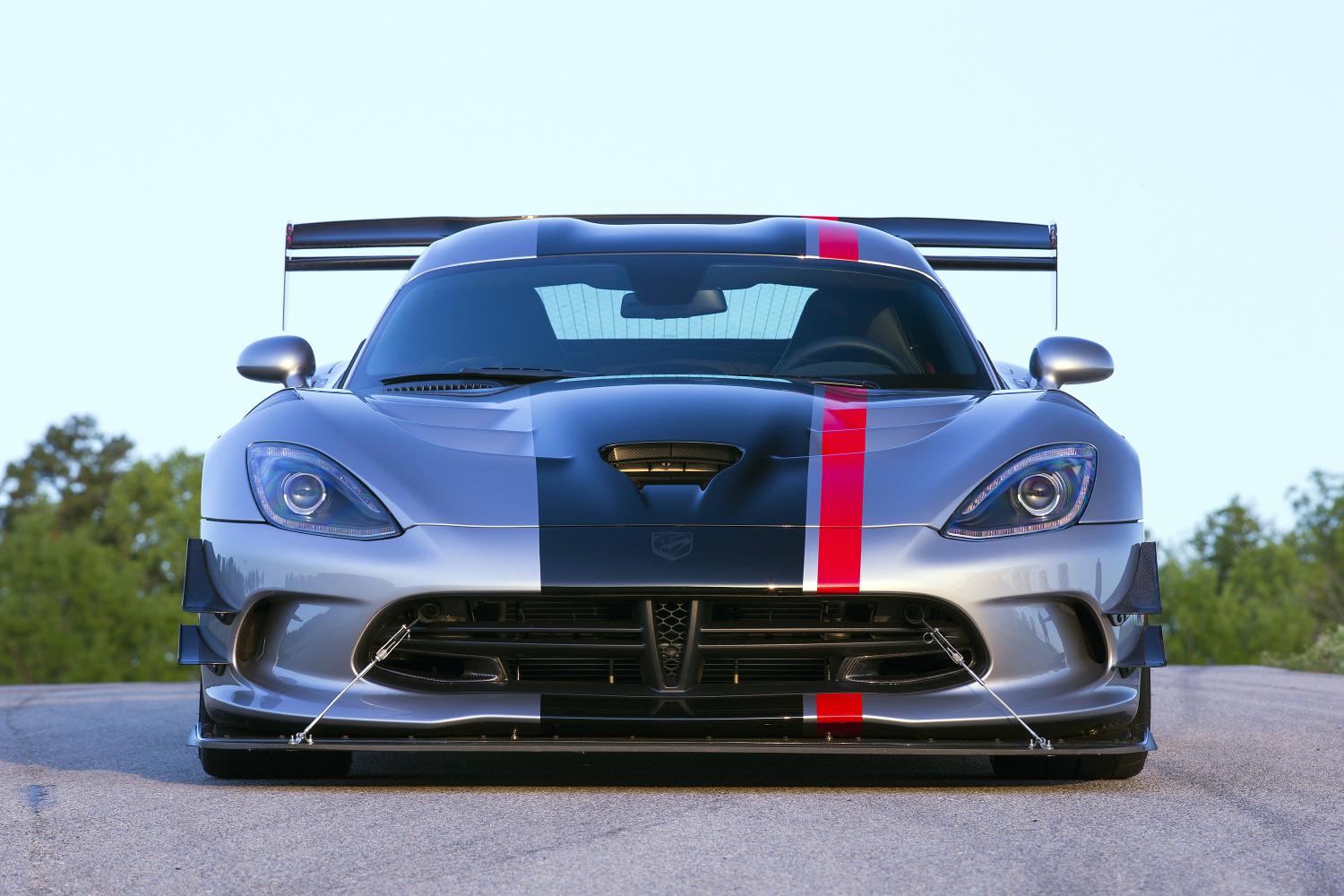
Ultimate aerodynamic performance
The 2016 Dodge Viper ACR with the available Extreme Aero package produces the highest aerodynamic downforce of any production car. During on-track testing, development engineers have experienced nearly 1 ton of downforce at top speed of 177 mph.
The Extreme Aero Package includes a huge (1,876-mm wide) adjustable dual-element rear wing, rear carbon fiber diffuser, unique SRT hood with removable louvers, detachable extension for the front splitter and four dive planes. The Extreme Aero rear wing, specifically designed for air flow around the Viper’s body, stands taller, sits further rearward and features unique end-plates and gurney lip to produce maximum downforce while minimizing straight line drag. The Extreme Aero package delivers more than three times the downforce of the Viper TA (Time Attack) 2.0 package.
The rear carbon fiber diffuser extends forward of the rear axle. It includes six removable strake extensions, designed to rub against the track surface for increased straight-line stability and optimized downforce. Removable hood louvers over the front tires reduce air pressure in front wheel wells to provide additional downforce. The detachable front splitter extension and dive planes work with the rear aero treatment to provide outstanding grip and balanced performance on the track.
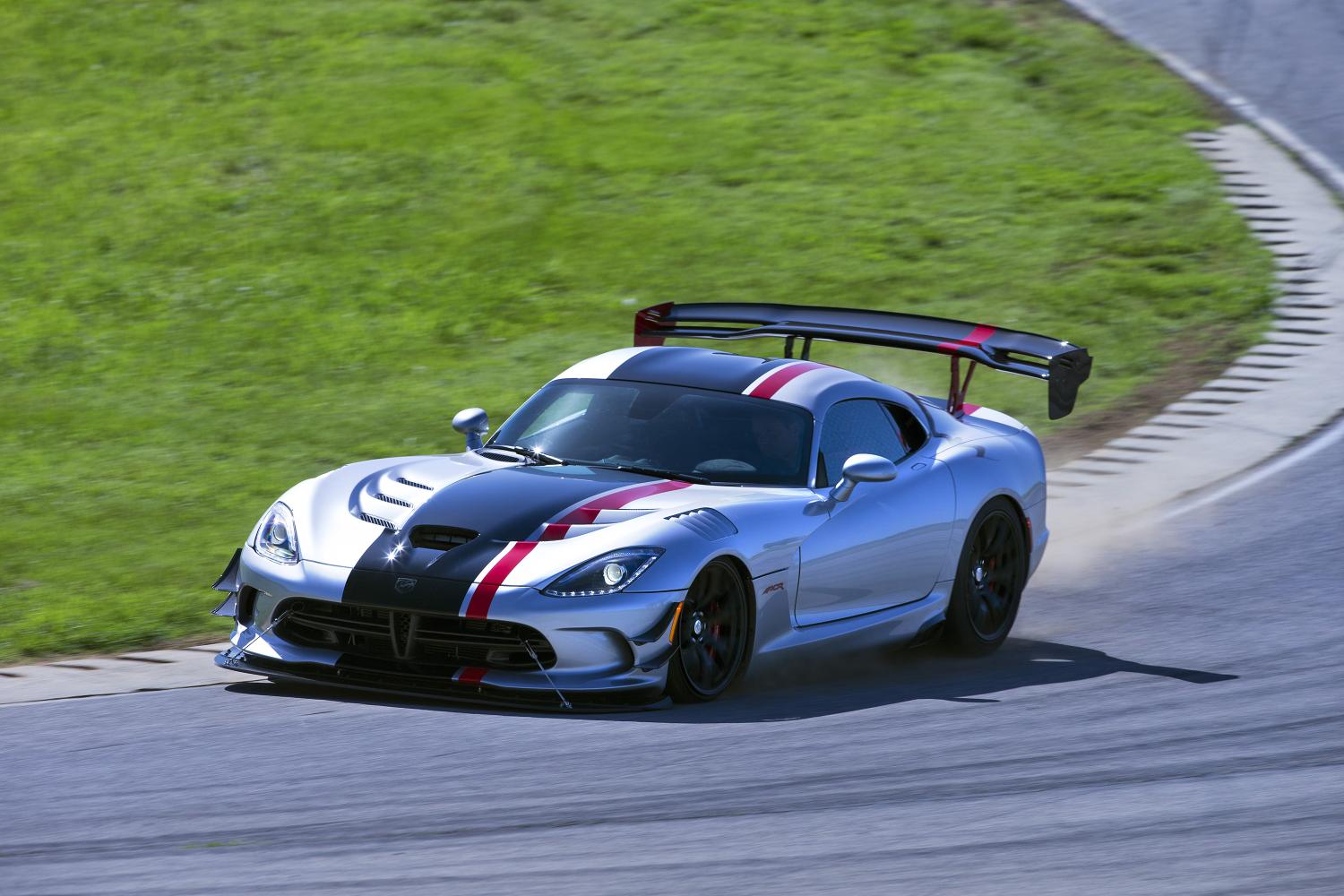
Ultimate brake performance
Track duty can punish the brakes. The 2016 Dodge Viper ACR features new Brembo® Carbon Ceramic Matrix brakes for optimum braking performance with unprecedented brake fade resistance, and greater handling capability through reduced un-sprung weight. The system uses 390-millimeter (15.4-inch) two-piece front rotors and 360-millimeter (14.2-inch) two-piece rear rotors. Front brakes use six-piston Brembo® calipers while the rear brakes use four-piston calipers.
The new Carbon Ceramic Matrix brakes have the largest brake pad area ever on Viper. The brakes work in conjunction with ABS and ESC specifically tuned for ACR to take into account the extra grip provided by the additional aero and specifically designed Kumho® tires. Detachable front brake ducts provide additional cooling to the brake calipers for optimum track performance.
Tire, Chassis Combo Keeps Viper ACR Glued to the Road
The 2016 Dodge Viper ACR is fitted with Kumho® Ecsta V720 high-performance tires designed specifically for the car with unique tread pattern and compounds for front and rear. In testing, the new tires produce laps times that are 1.5 seconds faster than off-road only race tires.
Low-profile front tires measure 295/25/19 and are mounted on wider 11-inch wide wheels and when combined with the 355/30/19 rear tires provide the largest combined tire patch available on any production car. On the sidewall of the new tires is a unique raised ACR logo.
The Viper ACR’s ABS and five-mode Electronic Stability Control system (Full-on, Sport, Track, Rain, Full-off modes) are specifically tuned for the car to take into account the extra grip offered by the extreme aerodynamic and tire package.
Aluminum bodied, double-adjustable coil-over Bilstein race shocks are designed specifically for the Viper ACR and work in conjunction with ride height adjustment for optimal control of weight transfer and handling performance. Each shock provides independent 10-way rebound and compression adjustability. The suspension package also provides more than 3 inches of ride height adjustment.
Front springs are rated at 600 lbs./in. and rear springs at 1,300 lbs./in., more than double the suspension stiffness of the Viper TA model. With unique race alignment and 1.4 degrees more negative camber than the entry SRT model, the 2016 Dodge Viper ACR is capable of sustaining more than 1.5 g on high-speed turns due to the combined chassis and aerodynamic improvements.
“This car is not a 1-3 lap track special. You can run the car at the track all day, and the performance doesn’t fall off,” added Kuniskis.
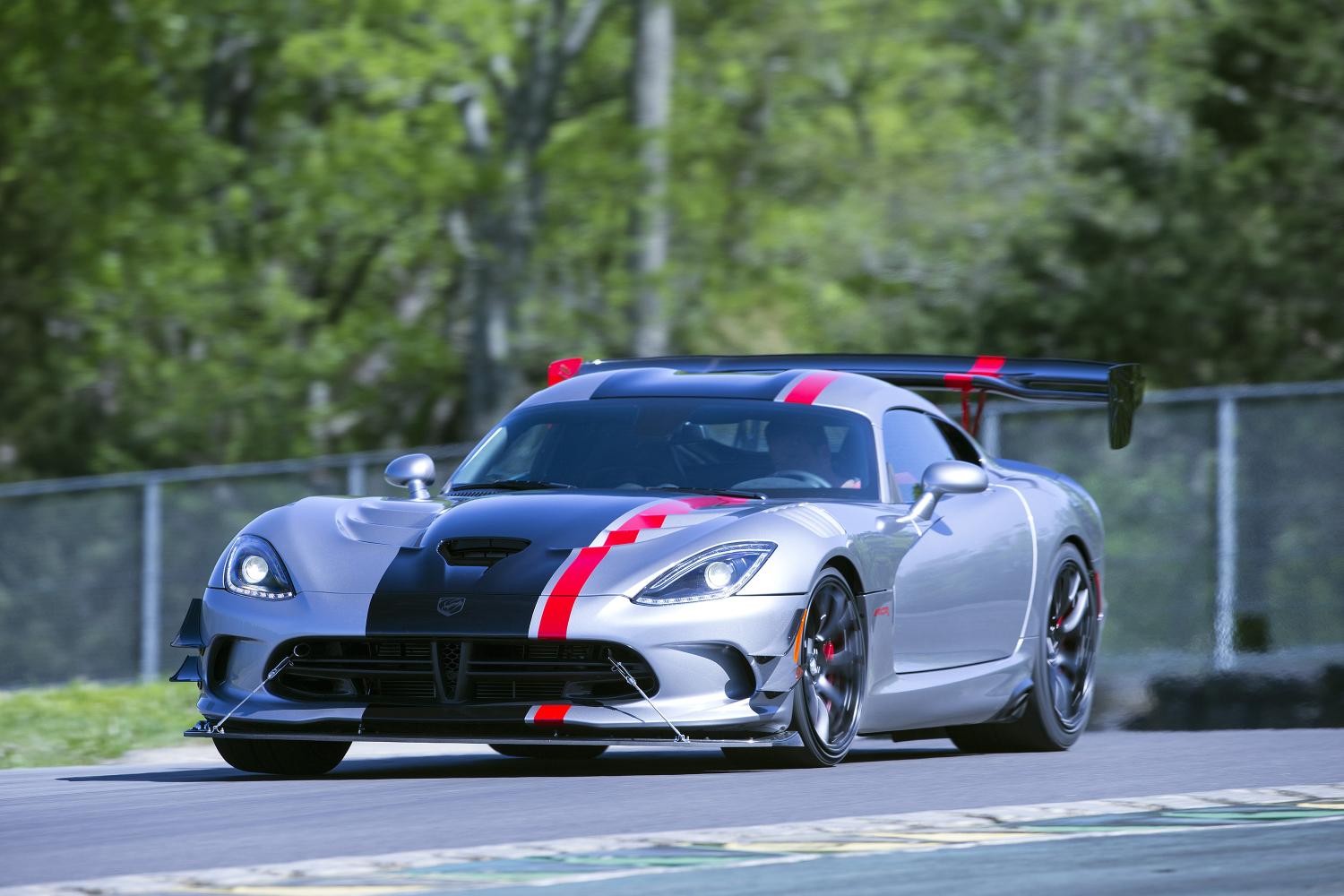
Awe-inspiring V-10 Powertrain
At the heart of the 2016 Viper ACR is the handcrafted, all-aluminum 8.4-liter V-10 overhead-valve engine, rated at 645 horsepower and 600 lb.-ft. of torque – the most torque of any naturally aspirated sports-car engine in the world. Unique exhaust tips have been added to the side-mounted exhaust pipes to provide reduced exhaust pressure. All Vipers are engineered to withstand severe track duty in ambient temperatures of 100 degrees Fahrenheit with a professional driver. Power reaches the pavement through the standard Tremec TR6060 six-speed manual transmission.
ACR-exclusive Interior Appointments
The instrument panel cluster hood, lower instrument panel and door armrest panels of the race-inspired interior are wrapped in unique Alcantara suede. A new, ACR-exclusive Alcantara wrapped high-grip steering wheel with color racing stripe and unique badging sets the ACR apart from other production models. New high-grip seats also carry the Alcantara inserts, while the unique dash plaque is finished in carbon fiber. Customers can choose between silver or Header Red accent stitching throughout the interior.
‘1 of 1’ Viper Program Offers One-of-a-Kind Street-Legal Race Car
Applying Viper’s exclusive ‘1 of 1’ customization program to Viper ACR allows customers to have more than 25 million build combinations to create their one-of-a-kind Snake from the ground up. With 8,000 exterior color options, 24,000 custom stripe colors, 11 wheel options, 16 interior trims and seven aero packages, three brake packages and four suspension options there are more than 25 million ways for buyers to customize their one-of-a-kind Dodge Viper.
Hand-built in Detroit at the Conner Avenue Assembly Plant; the 2016 Dodge Viper ACR goes on sale in third quarter 2015.
ACR History
The original Dodge Viper ACR was produced for the 1999 model year and was based off of the second generation coupe. This model had suspension and engine enhancements focused on maximizing performance in road racing and autocross environments. Horsepower was bumped from 450 to 460 hp via a unique air filter and smooth air intake hoses. Curb weight was reduced by more than 50 pounds by stripping the audio system and removing other non-essential items such as the fog lamps. The new stiffer, adjustable suspension removed another 14 pounds. This model also had an “ACR” badge and 20-spoke BBS wheels.
The second version of the Viper ACR was based off of the fourth generation coupe and was built during the 2008-2010 model years.
The 2008/2009 Viper ACR maintained the standard Viper’s 600 hp and 560 lbs.-ft. of torque, while adding aerodynamic, brake and suspension upgrades to the already potent supercar. One development goal was 1,000 pounds of downforce at 150 mph with optimum aero balance – a target achieved through CFD and wind-tunnel testing. Unique coil-over shocks allowed height changes and were step adjustable for compression and rebound.
Spring and anti-roll-bar rates were increased and the ACR was fitted with forged aluminum wheels and track-ready race tires. The new wheels and tires combined with a new two-piece brake rotor system shaved approximately 40 pounds from a base Viper. An additional 40 pound savings (for a total of 80) was possible when ordering the Hard Core Package which removed the audio system, trunk carpet and sound insulation. The 2008 Viper ACR proved its ultimate performance formula by setting a new track record at the famous 12.9-mile Nürburgring Nordschleife circuit in Germany with an elapsed time of 7:22.1.
For the 2010 model year, the Viper ACR was upgraded further with a redesigned rear wing gurney and end plates to further optimize aerodynamics and improve rear yaw downforce. In addition, a shorter fifth gear ratio improved high-speed acceleration and produced higher straightaway speeds. This improvement was a direct result of SRT’s experience at the Nürburgring Nordschleife where the team found that a revised gear ratio would have resulted in a higher speed capability and potentially a shorter elapsed time. In late September 2011, Dodge returned to the famed circuit and recaptured the production car lap record with a time of 7:12.13.
In late 2009, Dodge announced the non-street legal Viper ACR-X, targeted at the grassroots racer.
Combining the best performance attributes of the record-setting, street-legal Dodge Viper ACR and the safety equipment of championship-winning Viper Competition Coupe, Dodge produced the non-street legal racer that made its on-track debut in the summer of 2010 as part of Dodge Viper Cup spec racing series.
The 2010 Dodge Viper ACR-X was also powered by a 8.4-liter V10, equipped with factory-installed headers, forged pistons and a low-restriction exhaust system that produced 640 horsepower (40 more than production model).
The suspension also was tuned and upgraded specifically for on-track usage, while the weight was lightened by a full 160 pounds (versus the standard production Viper) to take on even the most challenging road course. Additional aerodynamic upgrades improved downforce, while enhancing stability and significantly improving grip in high-speed cornering.
Similar to the Dodge Viper Competition Coupe, the Viper ACR-X contained factory-installed safety equipment such as a factory-designed roll cage, fuel cell and race seat.

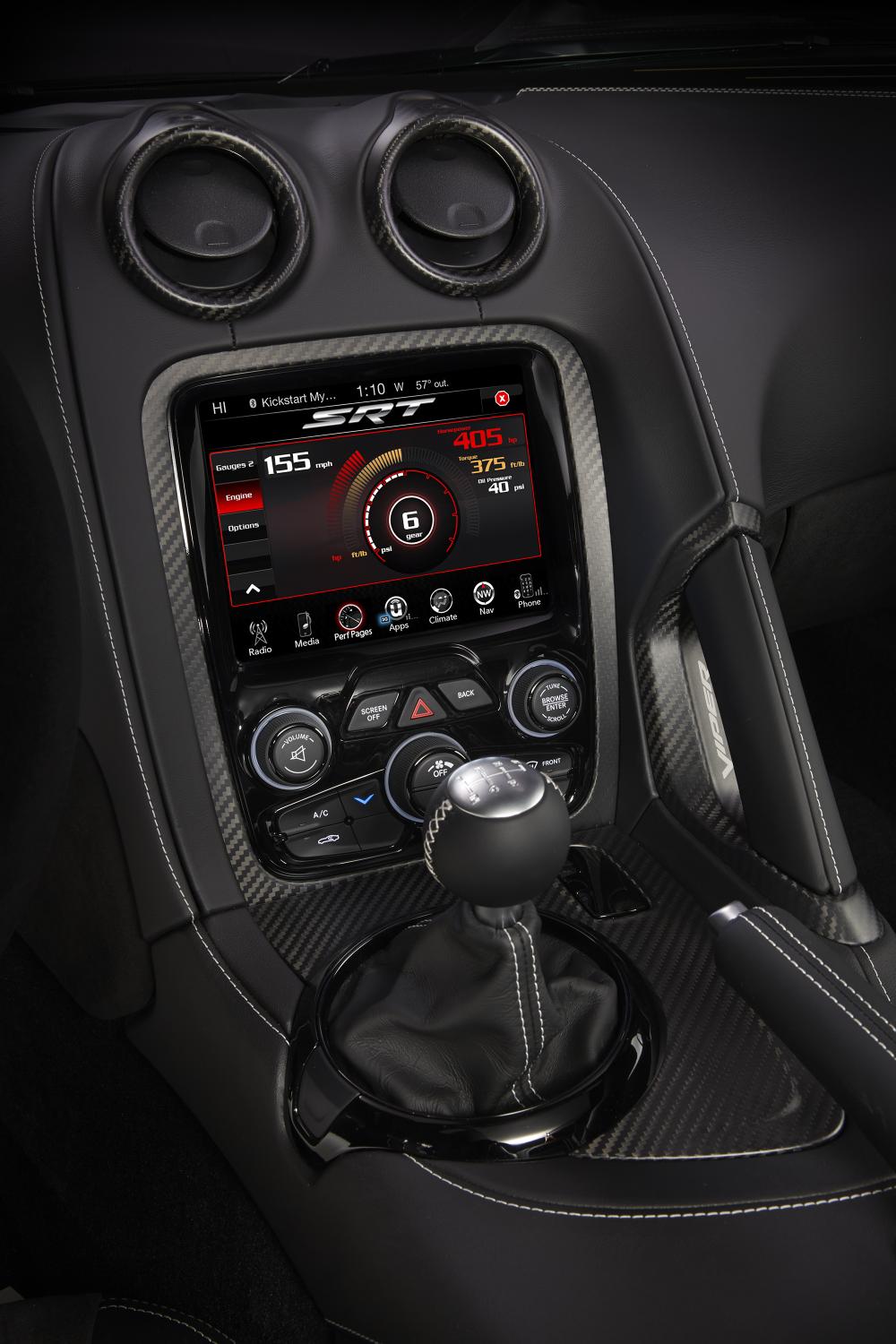
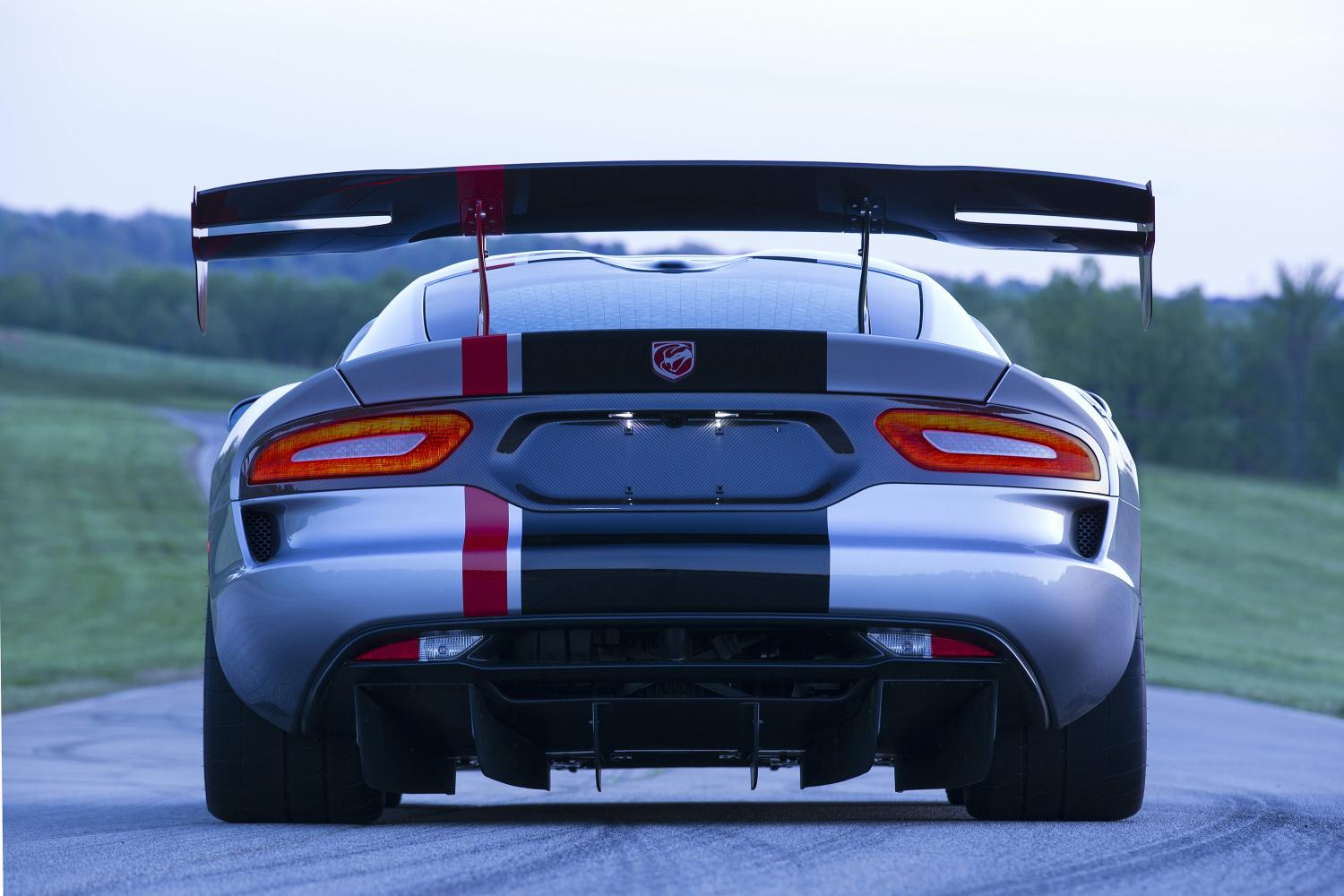
DODGE’S LEGENDARY SNAKE HAND BUILT IN THE HEART OF DETROIT
- First Viper was built at Conner Avenue Assembly Plant 20 years ago
- More than 24,000 Dodge Vipers began life south of 8 Mile Road
- Each vehicle hand built by skilled craftspeople
- A new Viper rolls off the assembly line every 10 days
- It takes 145-160 man hours to prep, paint and finish the Viper’s body panels
- Workforce partners with Operation Get Down to support those in need
May 8, 2015 , Detroit – Tucked in a Detroit neighborhood south of the famed 8 Mile Road is the birthplace of one of the most exotic American supercars on the road today – the Dodge Viper.
The Conner Avenue Assembly Plant has been hand building the exclusive Dodge performance flagship since 1995. Through 2014, more than 24,000 Vipers have rolled off the line of the nearly 400,000-square-foot facility under the watchful eyes and dedicated hands of 64 of the most skilled auto workers in the industry. (Initially built at the New Mack Assembly Plant, approximately 30,000 Vipers have been built since it was introduced in 1992.)
“The motto of the Conner Avenue plant is ‘dedicated people building dreams’,” said Doug Gouin, Conner Avenue Assembly Plant Manager, FCA US LLC. “The plant is filled with some of the most amazing car builders in the auto industry, building a vehicle that most people can only aspire to. The workers here are craftspeople, committed to delivering the best quality vehicle possible to our customers. Some of them are Viper owners themselves, so the job becomes very personal. They know they are keepers of the Viper legacy.”
The future of Conner was uncertain when the former Chrysler Group idled the nearly 50-year-old plant in 2010. After a two-year hibernation and a new lease on life, the plant reopened in 2012 to build the new fifth generation Viper. Everything was refurbished and improved, from the lobby, where a historical Viper timeline hangs, to the 14 restrooms and the shop floor, which is now hospital-clean, bright and more organized to increase the efficiency of each operation.
With all of the improvements, the Conner Avenue Assembly Plant looks like a modern, state-of-the-art facility, even though it bows to its original coach builder philosophy. After nearly 23 years in production, the plant still maintains the handcrafted build process that added to the mystique of the original Viper. All of the operators were specially selected to meticulously assemble each component with complete attention to detail and quality. For every member of the Viper team, it is truly a labor of love.
“There is a sense of pride about being part of the Viper team,” said Greg Rinehart, a Team Leader who has been with Viper since 1994. “Every vehicle that leaves this plant is like one of our children. Each owner becomes part of our family. We were grateful when they decided to bring Viper back and gave us the opportunity to be part of the future.”
No Vehicle Before Its Time
The unique character of the Viper means a unique approach to building it. Compared to a regular assembly plant where a vehicle rolls off the line every minute, a Viper cycles down the line every 146 minutes. As a result, each operator is completing 150 elements or tasks in a single cycle. This is equivalent to what 100 people would do in a plant like the Company’s Jefferson North Assembly Plant, where the Jeep® Grand Cherokee and Dodge Durango are built just down the road and which produces more than 300,000 vehicles each year.
There are three main build areas inside the Conner Avenue plant – the chassis line, the engine line and the final line.
The Dodge Viper begins to take shape on the chassis line. The frame is shipped to Conner from an outside supplier in Kentucky to begin its 10-day journey down the assembly line.
With a nod to modern production techniques and a focus on quality, Conner installed its first robots on the floor when production relaunched in 2012. The five robots that make up the Net Form & Pierce cell move the frame in and out five times during one cycle, punching holes and creating 50 features in the Viper frame to establish the dimensional environment to hang panels, such as the hood, deck lids, doors and fenders. The robots then measure 65 vision points to ensure the accuracy of the installation points for other components. Drag strip lights indicate what stage of the process the frame is in. At the conclusion of the cycle, the frame exits the cell and has the instrument panel mounted, which is built up onsite.
Along the chassis line, the operators turn the steel frame into a fully functioning, driveable “go cart” that looks more like something out of a science fiction movie than the sleek, American supercar that will ultimately hit the road. Operators install all of the components that make the Viper run, like front and rear suspension, rear brakes, exhaust, fuel tank and the V-10 engine.
The legendary Viper V-10 engine is also hand built at Conner in six stations, along with its all-important pistons. Prior to 2012, pistons for the previous generation Viper came already assembled from the FCA US Saltillo, Mexico, Engine Plant. To ensure the maximum performance quality of each engine, all V-10s are now 100 percent dyno tested before finding a home in a vehicle.
“The V-10 engine is one of the hallmarks of the Viper, so it is critical that its performance can support the legacy,” said Gouin. “Moving the piston build to Conner and dyno testing every engine allows for better quality control, which is important when you’re building an American supercar like this.”
Before wheels and tires are installed, the vehicle goes through the aligner, a piece of equipment that was fully refurbished from the Prowler production days, to ensure proper camber alignment.
The last stop on the chassis line before moving to the final line is the roll test, where each vehicle is tested up to 90 mph. Conner also repurposed the rolls previously used for Prowler, but needed to make the rolls pit nine feet longer and five feet wider in order to accommodate cars with cladding.
Once the rolling chassis and its V-10 engine are validated in the rolls station, it heads to the final line, where body panels, seats, window glass, and other interior and exterior components come together in sequence to form that easily recognizable and timeless Viper shape.
The next steps after a Viper rolls off the line are headlight aim, which employs the same exacting equipment used at other hi-tech plants, and emissions testing. Every vehicle then goes through a five-minute water test, where it is pounded by 720 gallons of water, which are recycled and reused for a one week period. (Previously, the water was disposed of after each use.)
All vehicles now also go through the shaker. Installed in 2014, the shaker simulates the bumps and rough surfaces found on public roads to identify any buzz, squeaks or rattles. Weather permitting, employees at the plant still take one vehicle a day on a real road test as part of an additional quality audit.
To ensure the Viper has been built to its exacting standards, each vehicle is put through the new Vision Cell to measure 120 points along the body to verify the precision of the fit and finish.
Following a final electrical check, and buff and polish under special lights to make the paint gleam, the Viper heads to the covered shipping area where it will be loaded onto covered carriers for delivery to its anxious new owner.
Like most FCA US assembly plants, Conner also has a state-of-the-art Metrology Center, equipped with upgraded CMM capabilities and a Quality Assurance Fixture, to verify and maintain the dimensional quality of the Viper.
The entire facility was upgraded with WiFi three years ago to support the use of RF (radio frequency) reporting tools throughout. These portable tools are used to assemble the car and help verify that the right torque is used in each assembly operation. Having wireless tools eliminates possible trip hazards and reduces maintenance costs.
The Conner workforce has spent the last three years implementing World Class Manufacturing (WCM), a methodology that focuses on reducing waste, increasing productivity, and improving quality and safety in a systematic and organized way. WCM engages the workforce to provide and implement suggestions on how to improve their jobs and their plants. WCM was first implemented by Fiat in 2006 and introduced to the former Chrysler Group as part of the alliance between the two companies in June 2009.
As a result of those efforts, Conner is reducing the amount of line side inventory – considered waste – by doing more kitting. Kits, which include specific components for each station, are assembled in an adjacent kitting area and are then delivered just in time and just in sequence to the operator on the line.
“Because the workforce here has embraced the WCM methodology, they have ensured that the highest quality vehicles in the industry are built at Conner,” said Gouin.
To pay homage to the Viper’s performance roots, Conner has integrated racing themes across the facility. Aisles are named for famous racing venues like Sebring and Nürburgring, and are color coded to match the columns. The walkways have checkered flag decals indicating pedestrian zones.
Painted to Perfection
The painting process of a Viper body is also unique. All Vipers are painted at Prefix Coatings in Auburn Hills, Mich., which has been in business for more than 30 years. Each vehicle is hand painted by skilled craftsmen hired for their reputation for painting show cars and custom cars.
For each Viper, Prefix paints 20 parts, which are spread over two racks and kept together to ensure color harmony. It takes from 145-160 man hours to prep, paint and finish the body panels. The panels spend about two weeks in the Prefix plant, from the time they arrive to when they are shipped to Conner.
Previously, all Vipers were shipped to an outside supplier for the application of stripes. Starting in 2012, Prefix adds the “buried” painted stripe to the Viper in a labor intensive, proprietary process that can take about 18 hours to complete. Panels are then delivered in sequence to Conner. By incorporating the stripe application into the painting process, it eliminated nearly two weeks from the assembly timing and reduced the risk of something happening to the vehicle while in transit.
